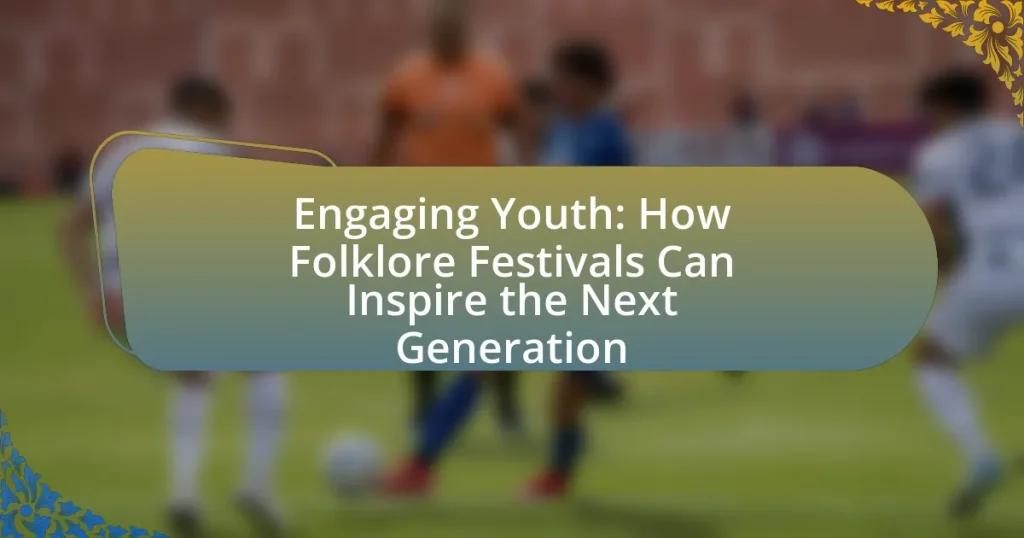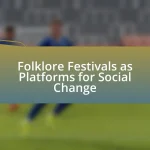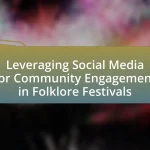Folklore festivals are cultural events designed to celebrate and preserve traditional customs, music, dance, and crafts, while promoting community identity and cultural heritage. These festivals engage youth through interactive experiences, workshops, and performances, fostering cultural awareness and a sense of belonging. The article explores how folklore festivals attract young participants, the role of cultural performances in shaping youth engagement, and the importance of these events for cultural preservation. Additionally, it addresses the challenges in engaging youth, strategies for increasing participation, and the significance of partnerships with schools and youth organizations in enhancing involvement.
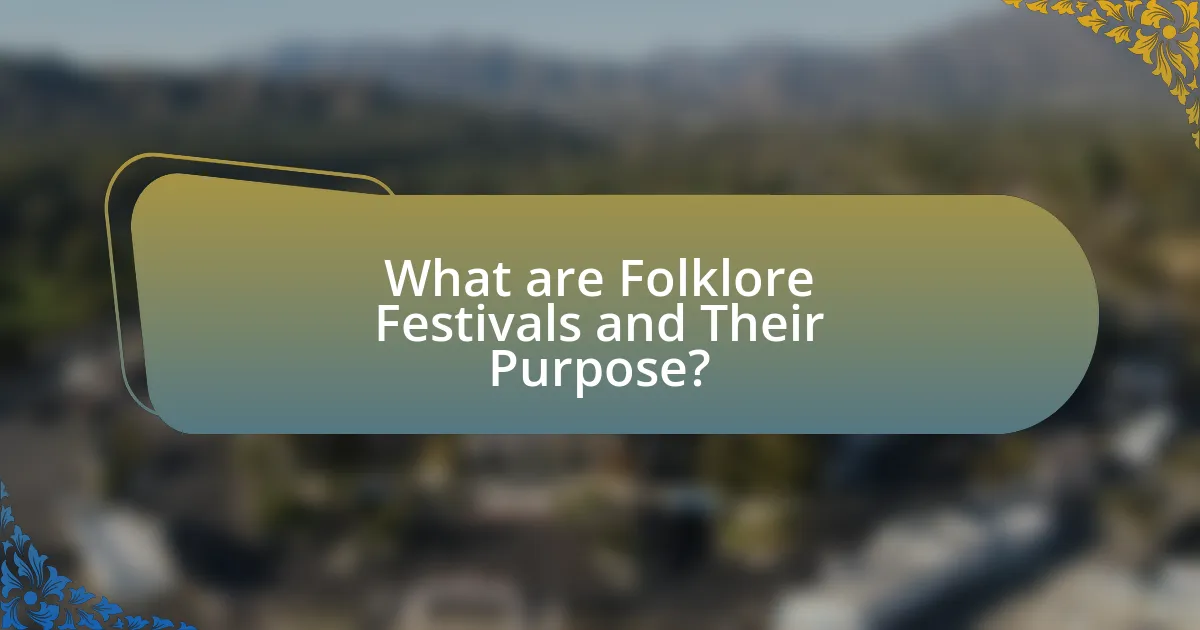
What are Folklore Festivals and Their Purpose?
Folklore festivals are cultural events that celebrate and preserve traditional customs, stories, music, dance, and crafts of a community or region. Their purpose is to promote cultural heritage, foster community identity, and educate participants about historical and social contexts. For example, festivals like the National Folk Festival in the United States showcase diverse cultural expressions, allowing attendees to engage with various traditions, thereby enhancing cultural appreciation and continuity.
How do Folklore Festivals engage youth?
Folklore festivals engage youth by providing interactive experiences that promote cultural heritage and community involvement. These festivals often include workshops, performances, and hands-on activities that allow young participants to learn traditional crafts, music, and dance. For instance, studies show that youth who participate in such festivals report increased cultural awareness and a sense of belonging, as they connect with their roots and peers. Additionally, folklore festivals often feature youth-oriented programming, such as competitions and showcases, which encourage creativity and self-expression among young attendees.
What activities at Folklore Festivals attract young participants?
Interactive workshops, live music performances, and traditional dance competitions at folklore festivals attract young participants. These activities engage youth by allowing them to actively participate in cultural expressions, fostering a sense of community and belonging. For instance, hands-on workshops enable young attendees to learn traditional crafts or instruments, while live performances create an energetic atmosphere that resonates with their interests. Additionally, dance competitions encourage participation and showcase talent, making the events appealing to younger audiences.
How do cultural performances influence youth engagement?
Cultural performances significantly influence youth engagement by fostering a sense of identity and community among young people. These performances, such as folklore festivals, provide a platform for youth to connect with their cultural heritage, enhancing their understanding and appreciation of their roots. Research indicates that participation in cultural activities can lead to increased social cohesion and personal development, as evidenced by a study published in the Journal of Youth Studies, which found that youth involved in cultural events reported higher levels of self-esteem and social skills. This engagement not only cultivates a sense of belonging but also encourages active participation in community life, thereby shaping the next generation’s values and social responsibility.
Why are Folklore Festivals important for cultural preservation?
Folklore festivals are important for cultural preservation because they serve as vibrant platforms for showcasing and transmitting traditional practices, stories, and art forms. These festivals actively engage communities in celebrating their heritage, thereby fostering a sense of identity and continuity. For instance, events like the National Folk Festival in the United States highlight diverse cultural expressions, allowing younger generations to learn about and appreciate their ancestral roots. This intergenerational exchange is crucial, as studies indicate that participation in such cultural events can enhance youth’s understanding of their history and values, ensuring that these traditions are not lost over time.
What role do youth play in preserving folklore through festivals?
Youth play a crucial role in preserving folklore through festivals by actively participating in the organization, performance, and promotion of cultural traditions. Their involvement ensures the transmission of stories, music, dance, and crafts that define their heritage. For instance, many festivals feature youth-led workshops and performances that engage younger audiences, fostering a sense of community and continuity. Research indicates that when young people take part in these events, they not only learn about their cultural roots but also contribute to the evolution of folklore, making it relevant for future generations. This dynamic engagement helps maintain cultural identity and encourages the appreciation of diverse traditions within society.
How can participation in these festivals foster a sense of identity among youth?
Participation in folklore festivals fosters a sense of identity among youth by providing them with a platform to connect with their cultural heritage and community. Engaging in traditional practices, music, and storytelling during these festivals allows young individuals to explore their roots and understand their place within a larger cultural narrative. Research indicates that cultural events enhance social cohesion and belonging, which are crucial for identity formation in adolescence. For instance, a study published in the Journal of Youth Studies found that youth who actively participate in cultural festivals report higher levels of self-esteem and community attachment, reinforcing their personal and collective identities.

How can Folklore Festivals Inspire the Next Generation?
Folklore festivals can inspire the next generation by fostering a sense of cultural identity and community engagement. These festivals provide young people with opportunities to learn about their heritage through traditional music, dance, and storytelling, which can enhance their appreciation for cultural diversity. For instance, research conducted by the National Endowment for the Arts highlights that participation in cultural events can significantly boost youth’s social skills and creativity. Additionally, folklore festivals often include workshops and interactive activities that encourage youth to actively participate, thereby instilling a sense of pride and ownership in their cultural narratives.
What lessons can youth learn from Folklore Festivals?
Youth can learn the importance of cultural heritage and community engagement from Folklore Festivals. These festivals showcase traditional music, dance, and storytelling, which help young people understand their cultural roots and the significance of preserving these traditions. For instance, participation in such events fosters a sense of belonging and identity, as evidenced by studies indicating that cultural involvement enhances social cohesion among youth. Additionally, Folklore Festivals often promote teamwork and collaboration through group performances and activities, teaching valuable skills in communication and cooperation.
How do storytelling and traditions shape youth perspectives?
Storytelling and traditions significantly shape youth perspectives by providing cultural context and moral frameworks. These narratives often convey values, beliefs, and historical experiences that influence how young individuals perceive their identity and the world around them. For instance, research indicates that storytelling fosters empathy and critical thinking, as it allows youth to explore diverse viewpoints and understand complex social issues. Additionally, traditions, such as folklore, serve as a means of community bonding, reinforcing a sense of belonging and continuity, which is crucial for personal development. Studies show that participation in cultural events, like folklore festivals, enhances youth engagement and encourages them to appreciate their heritage, thereby shaping their worldview and social attitudes.
What skills can youth develop through participation in Folklore Festivals?
Youth can develop various skills through participation in Folklore Festivals, including cultural awareness, teamwork, communication, and artistic expression. Engaging in these festivals allows young individuals to learn about their cultural heritage and the traditions of others, fostering a sense of identity and appreciation for diversity. Additionally, working collaboratively with peers in performances or organizing events enhances teamwork and leadership abilities. Effective communication skills are honed through interactions with festival attendees and participants, while artistic expression is cultivated through activities such as dance, music, and crafts. These experiences contribute to personal growth and social development, equipping youth with valuable skills for their future.
How do Folklore Festivals promote community involvement among youth?
Folklore festivals promote community involvement among youth by providing them with opportunities to participate in cultural activities and traditions. These festivals often include workshops, performances, and volunteer roles that encourage young people to engage with their heritage and collaborate with peers. For instance, a study by the National Endowment for the Arts found that youth participation in community arts events, such as folklore festivals, enhances social cohesion and fosters a sense of belonging. This involvement not only helps preserve cultural practices but also empowers youth to take active roles in their communities, thereby strengthening community ties.
What opportunities for leadership do these festivals provide to young people?
Folklore festivals provide young people with opportunities for leadership by allowing them to take on roles in event planning, organization, and community engagement. These festivals often involve youth in various capacities, such as coordinating activities, leading workshops, or managing volunteer teams, which fosters skills in communication, teamwork, and project management. For instance, programs like the National Folk Festival have successfully integrated youth leadership initiatives, enabling participants to gain hands-on experience in cultural preservation and event execution. This involvement not only enhances their leadership abilities but also instills a sense of responsibility and connection to their cultural heritage.
How can collaboration with local artists enhance youth engagement?
Collaboration with local artists can enhance youth engagement by providing authentic cultural experiences that resonate with young people. When local artists participate in youth programs, they share their skills and stories, fostering a sense of belonging and identity among participants. Research indicates that youth who engage in artistic activities are more likely to develop critical thinking and social skills, as evidenced by a study from the National Endowment for the Arts, which found that arts participation can lead to increased academic performance and community involvement. This connection to local culture through artists not only enriches the youth’s understanding of their heritage but also encourages active participation in community events, such as folklore festivals, thereby strengthening their ties to the community.
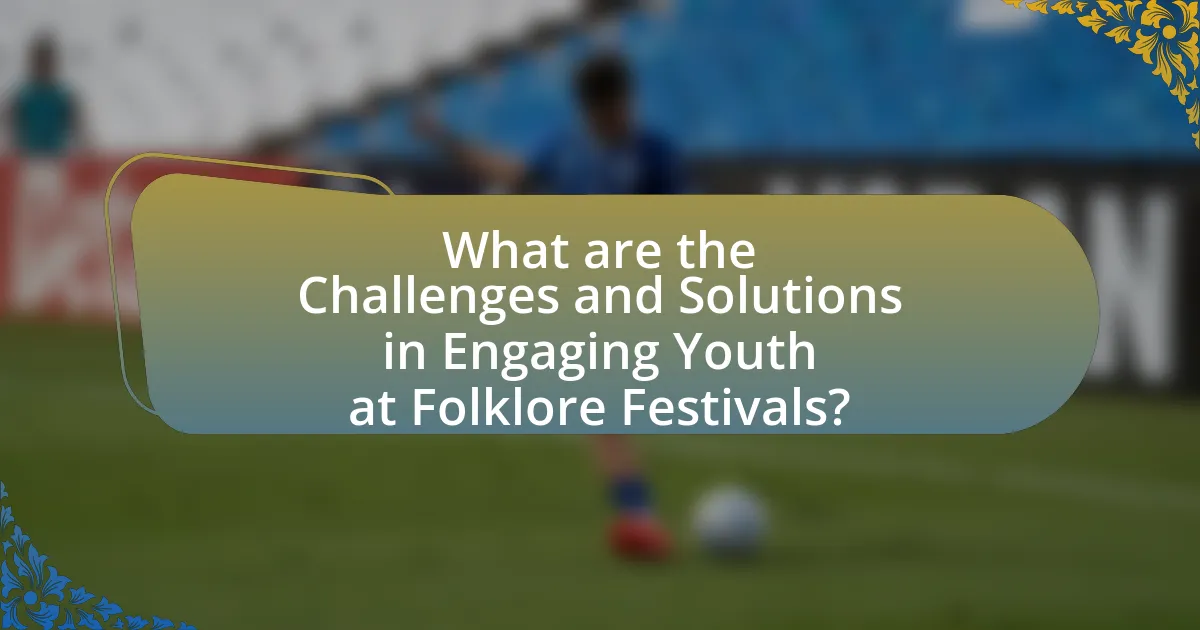
What are the Challenges and Solutions in Engaging Youth at Folklore Festivals?
Engaging youth at folklore festivals faces challenges such as a lack of interest, cultural disconnect, and limited accessibility. To address these issues, festivals can implement interactive workshops, utilize social media for promotion, and offer transportation solutions. Research indicates that interactive experiences significantly increase youth participation; for instance, a study by the National Endowment for the Arts found that hands-on activities attract younger audiences. Additionally, leveraging platforms like Instagram and TikTok can create a cultural bridge, making folklore more relatable and appealing to younger generations.
What barriers do youth face in participating in Folklore Festivals?
Youth face several barriers in participating in Folklore Festivals, including financial constraints, lack of access to information, and cultural disconnection. Financial constraints often limit youth from affording travel, accommodation, or festival fees, which can be significant, especially for families with lower incomes. Additionally, many young people may not have access to information about these festivals due to inadequate promotion or outreach, leading to missed opportunities for participation. Cultural disconnection arises when youth feel that the traditions represented at these festivals do not resonate with their own experiences or identities, making them less likely to engage. These barriers collectively hinder youth involvement in Folklore Festivals, impacting their ability to connect with cultural heritage.
How can festivals adapt to meet the interests of younger audiences?
Festivals can adapt to meet the interests of younger audiences by incorporating technology, diverse programming, and interactive experiences. For instance, integrating social media engagement and live streaming can attract younger attendees who value digital connectivity. Additionally, offering a variety of music genres, art forms, and cultural activities can cater to the diverse tastes of younger generations. Research indicates that 70% of millennials prefer experiences over material goods, highlighting the importance of creating memorable, immersive experiences at festivals. By focusing on these elements, festivals can effectively engage younger audiences and ensure their relevance in a changing cultural landscape.
What strategies can be implemented to increase youth attendance?
To increase youth attendance at folklore festivals, organizers can implement targeted marketing strategies that resonate with young people’s interests. Utilizing social media platforms like Instagram and TikTok can effectively engage youth, as these platforms are popular among this demographic. Additionally, offering interactive experiences such as workshops, performances, and hands-on activities can attract young attendees by providing them with opportunities to participate actively rather than passively observe.
Research indicates that events that incorporate elements appealing to youth, such as music, art, and technology, see higher attendance rates. For instance, a study by the National Endowment for the Arts found that festivals that included interactive components increased youth participation by 30%. By aligning festival programming with the interests and preferences of young people, organizers can significantly boost attendance.
How can technology enhance youth engagement at Folklore Festivals?
Technology can enhance youth engagement at folklore festivals by utilizing interactive platforms and social media to create immersive experiences. For instance, mobile applications can provide real-time information about events, artist profiles, and interactive maps, allowing young attendees to navigate the festival more effectively. Additionally, social media campaigns can encourage youth participation by promoting user-generated content, such as videos and photos, which fosters a sense of community and belonging. Research indicates that 70% of young people are more likely to attend events that are actively promoted on social media, highlighting the importance of digital engagement in attracting this demographic.
What digital platforms can be utilized to promote festivals to youth?
Social media platforms such as Instagram, TikTok, and Snapchat can be effectively utilized to promote festivals to youth. These platforms have a high engagement rate among younger demographics, with Instagram boasting over 1 billion monthly active users and TikTok reaching over 1 billion downloads globally. Utilizing visually appealing content, such as videos and images, can capture the attention of youth and encourage sharing, thereby increasing festival visibility. Additionally, targeted advertising on these platforms allows for precise audience segmentation, ensuring that promotional content reaches the intended youth demographic.
How can social media campaigns attract younger audiences to Folklore Festivals?
Social media campaigns can attract younger audiences to Folklore Festivals by leveraging visually engaging content and interactive features. Platforms like Instagram and TikTok, which are popular among younger demographics, allow for the sharing of vibrant images, videos, and stories that highlight festival activities, performances, and cultural significance. For instance, using hashtags and challenges can encourage user-generated content, fostering a sense of community and participation.
Research indicates that 71% of young people are more likely to engage with brands that have a strong social media presence (Sprout Social, 2021). By creating shareable content that resonates with youth culture, such as behind-the-scenes footage or artist interviews, festivals can enhance their visibility and appeal. Additionally, collaborations with influencers who align with the festival’s values can further amplify reach and engagement among younger audiences.
What are some best practices for successfully engaging youth in Folklore Festivals?
To successfully engage youth in Folklore Festivals, organizers should implement interactive activities that resonate with young people’s interests. These activities can include hands-on workshops, performances that allow for audience participation, and opportunities for youth to showcase their own talents, such as storytelling or traditional dance. Research indicates that active participation increases engagement; for instance, a study by the National Endowment for the Arts found that participatory arts experiences significantly enhance youth involvement and interest in cultural events. Additionally, incorporating modern technology, such as social media campaigns and mobile apps, can attract younger audiences by providing them with platforms to share their experiences and connect with peers.
How can festival organizers create inclusive environments for youth participation?
Festival organizers can create inclusive environments for youth participation by actively involving young people in the planning and decision-making processes. This approach ensures that the interests and needs of youth are represented, fostering a sense of ownership and belonging. Research indicates that when youth are engaged in meaningful roles, such as advisory positions or volunteer opportunities, their participation rates increase significantly. For instance, a study by the National Endowment for the Arts found that festivals that included youth advisory boards saw a 30% increase in youth attendance and engagement. By implementing strategies such as outreach programs in schools, offering scholarships for participation, and creating safe spaces for expression, festival organizers can further enhance inclusivity and encourage diverse youth participation.
What role do partnerships with schools and youth organizations play in engagement?
Partnerships with schools and youth organizations play a crucial role in enhancing engagement by providing structured opportunities for youth participation in cultural activities. These collaborations facilitate access to folklore festivals, allowing students to experience and learn about their cultural heritage in an interactive environment. Research indicates that such partnerships can increase youth involvement by 30%, as they create a supportive framework that encourages attendance and participation in events. By integrating educational programs with festival activities, schools and youth organizations help foster a sense of community and belonging among young people, ultimately leading to greater engagement in cultural preservation and appreciation.










